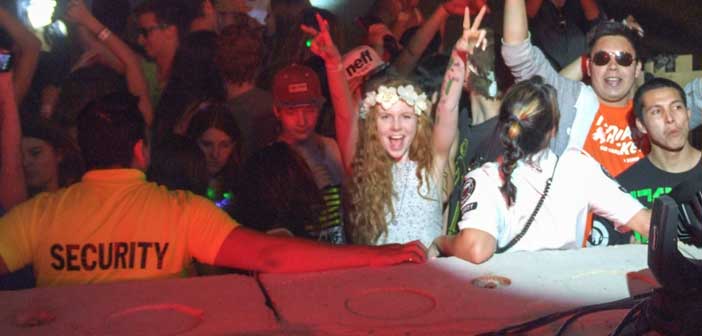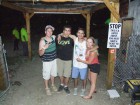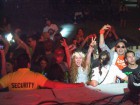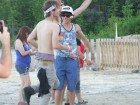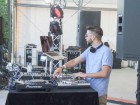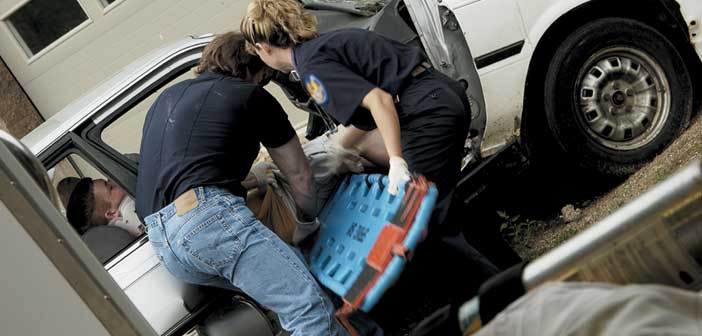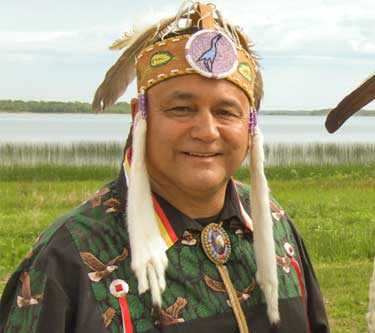LITTLE CURRENT—The pulsating beat of electronic dance music (EDM) began to thrum through the air at the Flat Rock Entertainment Centre on Harbour View Road in Little Current well before the sun went down on Friday night but with only a handful of figures dancing in front of the stage—but once the sky darkened and the lightshow began to stretch skyward, the EDM siren call pulled the crowd out onto the dance floor. By the time headliners A Tribe Called Red took to the turntables, the front of the stage was packed with bodies writhing to the beats, hands (and cellphones) held high in the air.
DJ Neon Nomad (Kagawong’s Jesse Bilbija now living in North Bay) is one of the up-and-coming EDM DJs who brought their talents to the inaugural FREC ME EDM music festival that took place over the June 27 weekend.
DJ Neon Nomad has been involved in the EDM music scene for about six years, starting out by operating a music blog (an Internet music commentary focussed on his favourite music). “Originally, I ran a blog and that went well for a while,” he said. “DJing just seemed like a natural fit. Instead of just songs, I was showing my mix.”
To an older crowd, EDM seems very similar to the disco scene of the 1970s and 80s. “That would be a pretty good take on it,” said Mr. Bilbija. The common themes are definitely dancing and having a good time. Certainly there were plenty of good vibes in the venue. (Sorry disco haters; it isn’t dead it’s been reincarnated.)
EDM has been described as being the realm of twenty-somethings, with fans generally topping out at around 35 years of age but there were a few grandmothers taking in the night. “My 35 year-old is not here, but I am,” said one woman with a shrug as she headed back onto the grounds from her campsite. “But it is a pretty young crowd.”
DJs generally come to the stage with about 60 to 70 ‘songs’, musical arrangements of electronically generated beats, tempos and rhythms, but it is in creating a seamless link between each song where the master DJs excel. “Ideally, there should be no discernable passage or break from one song to the next,” said Mr. Bilbija.
In front of the DJ are turntables (usually two) and controllers through which the DJ controls the beats per minute and pitch. “Everything has to be perfectly blended,” said Mr. Bilbija.
Much of the equipment used by DJs are Yamaha products, with “Pioneer CDJ 2000s and mixers, DJM 2000 to 900s, being pretty standard,” said Mr. Bilbija, slipping easily into the technical terminology that is the lifeblood of a musical genre that flourishes among bits and bytes of the digital age. Although the operators of a particular festival usually provide a standard setup for the visiting DJs, each DJ has their own preferred set of equipment that allows them to orchestrate the music to their particular style, he explained. “That is why you see that flurry of activity between acts as they move one DJ’s equipment out and set up the next,” he said.
EDM is almost entirely made up of electronically generated sounds, riffs and rhythms that have proven popular over the years, but it is the DJ who determines how that music is presented, sometimes on the fly, adjusting to the mood and flow of the crowd. Getting it just right is a game of nanoseconds, Mr. Bilbija told The Expositor.
The host of lights that streak across the sky and flicker through the crowd adds a great deal to the club scene, but those are usually provided by the venue.
“The clubs bring in their own professional light crew to handle that part,” he said. A good thing, since just purchasing the host of lights would run to the many tens of thousands of dollars.
Mr. Bilbija said that there were a couple of acts that he was very excited to see at the FREC ME festival. The group A Tribe Called Red topped that list, although the impossibly young DJ Maxim (just 16) came in a close second.
“I have been following A Tribe Called Red for quite a while now, but this was the first time I have been actually able to see them live,” he said. “They are really taking the music up to a whole new level on the global scene.”
A Tribe Called Red, an Ottawa based urban aboriginal group, has drawn deep from its cultural roots, melding powwow singing and drums into a 21st century mélange of reggae, rap, hip hop—and a host of other modern genres that leave a middle aged reporter blinking and reaching for Google—into a unique style that is blazing trails across the global music scene.
“(DJ) Maxim is just amazing, he is still just a kid, but he is up there with the best right now and he hasn’t even hit his stride yet,” enthused Mr. Bilbija. “What he is doing up there (mixing and blending the music together) he is doing all by ear.” Instead of relying on premixed blends and the many programs now available to assist DJs in their onstage mixes, DJ Maxim “does it old school,” if such a term can be used with such a new musical genre and technique.
EDM as a musical form is not going away any time soon (sorry again disco haters). “The form is really changing a lot and there are DJs who are taking it into many different musical styles, rock, jazz and even Motown,” said Mr. Bilbija. “It is becoming hard to identify the gaps between the genres.”
Part of the power and the attraction of EDM comes from its ease of access in the digital age. “There are lots of programs available for free on the Internet,” he said. A lot of people have uploaded their mixes to the net, he explains, and an aspiring DJ can access those resources and can learn from other DJs.
Provided they are willing to put in the time and the passion, they too can become masters.

